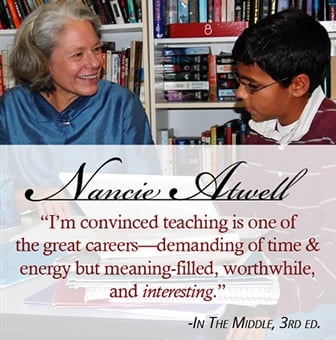
With our In The Middle Wednesday Series, Nancie Atwell gives us a guided tour of the upcoming Third Edition of In the Middle. This week she tells us why she chose to write the new edition now.
With our In The Middle Wednesday Series, Nancie Atwell gives us a guided tour of the upcoming Third Edition of In the Middle. This week she tells us why she chose to write the new edition now.
Congratulations on the third edition of In the Middle. It’s such a thorough, specific, generous description of your work and pedagogy. What made you decide to write it now, in today’s teaching climate?
Response written by Nancie Atwell
Since the last edition, I conducted almost a hundred seminars for teachers about writing-reading workshop, hosted hundreds more teachers at my school, the Center for Teaching and Learning, and responded to countless questions. I’m more aware than ever what teachers are wondering and what kinds of information and insights will help them in their day-to-day work in the classroom.
I also spent the past sixteen years teaching seventh and eighth graders. I developed new methods, refined old ones, and abandoned practices that I didn't feel were serving my students’ needs any longer. Just as teachers today recognize that writing is a process and a craft, we need to acknowledge that teaching, too, is a craft and a process. I continued to discover new methods, new genres to teach, and new language to use with my students to make the difficult doable.
The cover of the third edition proclaims, “Eighty percent new material,” and it’s at least that. Writing-reading workshop is still the gold standard—the only logical way to teach English. The last decade and a half has given me the opportunity to develop and experiment with approaches that help students become even stronger, more intentional writers and readers. I’ve learned a lot.
My seventh and eighth graders are expressive, effective writers. They read with enthusiasm, deep understanding, and critical insight. They are passionate about their literacy. I want this level of engagement and expertise for the students of every teacher. The third edition lays out in careful detail the deliberate environment of my classroom. It’s a set of blueprints for establishing the expectations, procedures, routines, and shared knowledge that invite every kid to experience and understand what writing and reading are good for.

In terms of today’s teaching climate, the book is also a reminder of the true basics in the language arts. It’s easy for teachers of English to lose focus and allow the CCSS to drive the curriculum. A writing-reading workshop satisfies the standards—and more. It hooks every child. Its individualization and emphasis on choice give all students an entry point, and its rigor and teaching structures support them as they make smart choices, work hard, and grow as writers and readers.
I worry that teachers feel pressured to approach writing and reading as subjects more closely aligned with the sciences than the humanities. Analysis, evidence, exposition, and nonfiction have important roles to play in an English classroom, but they aren’t the linchpins of the English curriculum. Stories and self-expression should be at the heart of our teaching, always.
Our job is to create writers and readers—people who use their literacy with purpose, pleasure, and skill, who have something at stake besides a test score. Students in a workshop engage and practice because writing and reading matter in their lives; they excel when their teachers know lessons, advice, and systems that support high-quality language learning.
The third edition of In the Middle is a big book. I packed it with my own lessons, advice, and systems. I hope it anticipates and answers teachers’ questions, provides the materials and models they need to make the workshop work for them, and, along with the two DVDs from Heinemann, Writing in the Middle and Reading in the Middle, shows what it looks and sounds like when a teacher asks students to act as real writers and readers across the genres.
I've loved my life in the classroom. This book is my invitation to other teachers to create the literary relationships with young people that drew them to English teaching in the first place.
This blog post is part of In the Middle Wednesdays. Please visit http://www.heinemann.com/inthemiddle/ to learn more.


